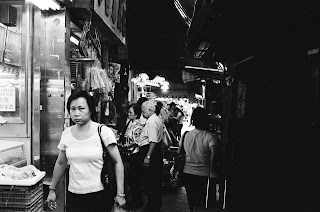07 December 2011
21 November 2011
Notes of Hong Kong, by Hugh Wilson













Sometimes it’s the way the crowd flows, sometimes it’s a hidden glance, or a color, or feeling, or moment. Out on the streets all the information is there – a thousand times all the great artworks – richness, emptiness, movement, stillness, beauty – beauty frozen by the most perfect compositions, impossible compositions. It passes by me over and over again, in different forms and ways, ways I couldn’t have imagined. It passes by with the ease of itself: the greatest designers and artists have always strived for it – and in their best works they find it, or a closeness to it.
When I am present on the streets I cannot move my camera fast enough, the moments are gone. I start chancing the photos, shooting at random, on the in-between moments, the valleys between the peaks, the emptiness. For each moment of perfection there are hundreds, maybe thousands, of imbalance, I don’t count them. I wait, I wait, looking… there. and there. I’ve learned that when I point I should snap instantly, that my eye and hand are truer than my mind, faster, but it’s still hard to do. I am learning to trust my hand; trust is difficult.
‘My hand learned from my eyes,
my eyes learned from my heart,
and my heart learned from the Hua Mountain.’
- unknown ancient Chinese artist
I’m shooting 35mm film. I have to wait days for developing. When I pick them up I am excited like a child. I flash through them, so many are nothing, they missed, then I stop – I look twice and my eye begins to move over the image wanting to leave but stays. It doesn’t mean the image is beautiful or whole, is as perfect as what is out there, but it has some thing.
Hugh Wilson is taking a break in Hong Kong after 3 months painting on a remote pacific island. He paints entirely from life. www.hugh-wilson.com
20 November 2011
[notes on a ginkgo biloba carpet, fall]
No one else seems to know about this tree, probably because it's mostly invisible from the street. Don't forget to look up. Our tree in October vs. November:
Why stalking is necessary: three days difference:
Through a Japanese Maple to the courtyard a few days before the Ginkgo leaves fall:
A few of my studies of a Ginkgo over a year:
Ginkgo Biloba trees are remarkable. They're considered living fossils with records dating back 270 million years. They have no living relatives. Clearly highly adaptable, they're also resistant to urban pollution which is unusual and makes them valuable in cities as a form of landscape infrastructure. Peter del Tredici, a great urban tree specialist, landscape architect, and ecologist, has written extensively on them. Check out the Harvard Magazine for more. Here's one of his images from a recent trip to discover naturally-occurring Ginkgo Biloba species in China:
I've been reading recently that they're at risk of not being planted as widely in cities because of the smell of the fruit the female tree produces. How quickly people forget that our world is more than just a visually-occurring place. It would be an ecological and experiential loss to our world to stop planting this great tree.
13 November 2011
[notes on framed views]
 |
| Framed sky at the Baptista, Florence Italy |
 |
| Early Islamic map of Mecca |
 |
| (Above) Binary window frame at L'Alhambra in Granada, Spain; Photo by Javier Carro (Below) Courtyard grove at Paradores L'Alhambra with box hedge, pen on paper, by the author |

 |
| Annette Hoyt Flanders “The Descent to the Woodland, Lewis L Estate, Syosset Long Island |
 |
| Annette Hoyt Flanders Century of Progress Exhibit, Chicago Symmetrical Box Hedges |
 |
| Annette Hoyt Flanders Classic Garden Century of Progress Exhibit 1934 |
 |
| Annette Hoyt Flanders, Location and designer unknown |
 |
| Annette Hoyt Flanders, Parterre Garden, McCann Estate, Long Island |
 |
| Annette Hoyt Flanders, Meadows from House Terrace, Oyster Bay, Long Island |
 |
| Annette Hoyt Flanders, Location unknown, likely Italy |
 |
| Annette Hoyt Flanders, Villa Gamberaia, Italy |
10 November 2011
[notes on eileen gray, modern intuitive designer]
 |
| Eileen Gray flanked by Le Corbusier and Jean Badovici |
 |
| Eileen Gray's Rue de Bonaparte apartment, Paris |
That her publicly-known history is half gossip, and that she went largely unrecognized and unknown until recently is not surprising and unacceptable. The story goes like this: she was a contemporary and supposedly longtime unrequited love interest of architect Le Corbusier (who drowned while oddly swimming off the cliffs of her house in the French Mediterranean). He was and perhaps continues to be credited with many of her designs.
The Dragon Chair was recently sold as part of Yves St. Laurent's collection for $28.3 million:
 |
| Dragon Chair Photos courtesy of Christie's |
 |
| Nonconformist Chair |
 |
| Transnat Chair |
 |
| Transnat Chairs, Pair |
She's perhaps most commonly known for her very modernist Bibendum Chair:
 |
| Rue de Lota apartment with her Pirogue chaise longue (also pictured below with lacquered screen) |
 |
| Dressing table |
Thanks to RISD professor, designer, chef Peter Tagiuri for introducing me to the intuition-driven work of this talented woman.
If you're interested in hearing my take on why it was she designed spaces so well, I'd be happy to elaborate. Thoughts?


































